Shime saba is a cured mackerel fillet that is great for sashimi as well as sushi topping. It is very simple to make and so tasty. All you need is mackerel, salt and rice wine vinegar. If you can get a very fresh mackerel, simply cure the fillet and turn it into one of the best sushi toppings! No cooking, just marinating!

Shime saba (しめ鯖, cured mackerel) is one of my favourites for sushi or sashimi. Come to think of it, I am actually fond of any fish that has shiny skin and non-white flesh, such as mackerel, yellow tail, and sardines.
When I order sushi at the counter of a traditional sushi restaurant, I always end up ordering these fish as the toppings. Because of the shiny skin, they are collectively called hikarimono (shiny thing) at sushi shops. And they are the kind of fish that contain good amounts of omega-3 fats. They might not look as elegant as white-meat fish, but they are good for you and flavoursome.
Depending on the season and where the fish was caught, the amount of fat contained in mackerel varies. I love the oily mackerel that you can eat in autumn and winter in Japan. It is so tasty, even without curing. Mackerel grilled with just a bit of salt is divine when the fish is oily.
Unfortunately, the mackerel sold in Sydney is not as oily as that in Japan but it is still my favourite. When I see fresh mackerel at the fish shop, I get an urge to buy it even if I’ve just had some a couple of days ago. I don’t know what it is but I just love mackerel.
Mackerel is called saba (鯖) in Japanese and the word shime (しめ) comes from the verb shimeru (しめる) meaning firm up the flesh of the fish/meat. Hence, this dish is called “shime saba” (しめ鯖).
Mackerel is the kind of fish which goes bad very quickly. So it is important to use a very fresh mackerel and certainly buy a whole fish, not one already filleted. I always ask the fish shop how fresh it is and if I could have it as cured meat.
I am a regular customer at the nearby fish shop so they do me a favour and prepare the purchased fish, even if the fish was very cheap (mackerel is much cheaper than other white-meat fish or tuna!). So I usually ask them to fillet the whole mackerel so I have two sides of fillet with the skin on. But sometimes when they are busy, I fillet the fish myself.
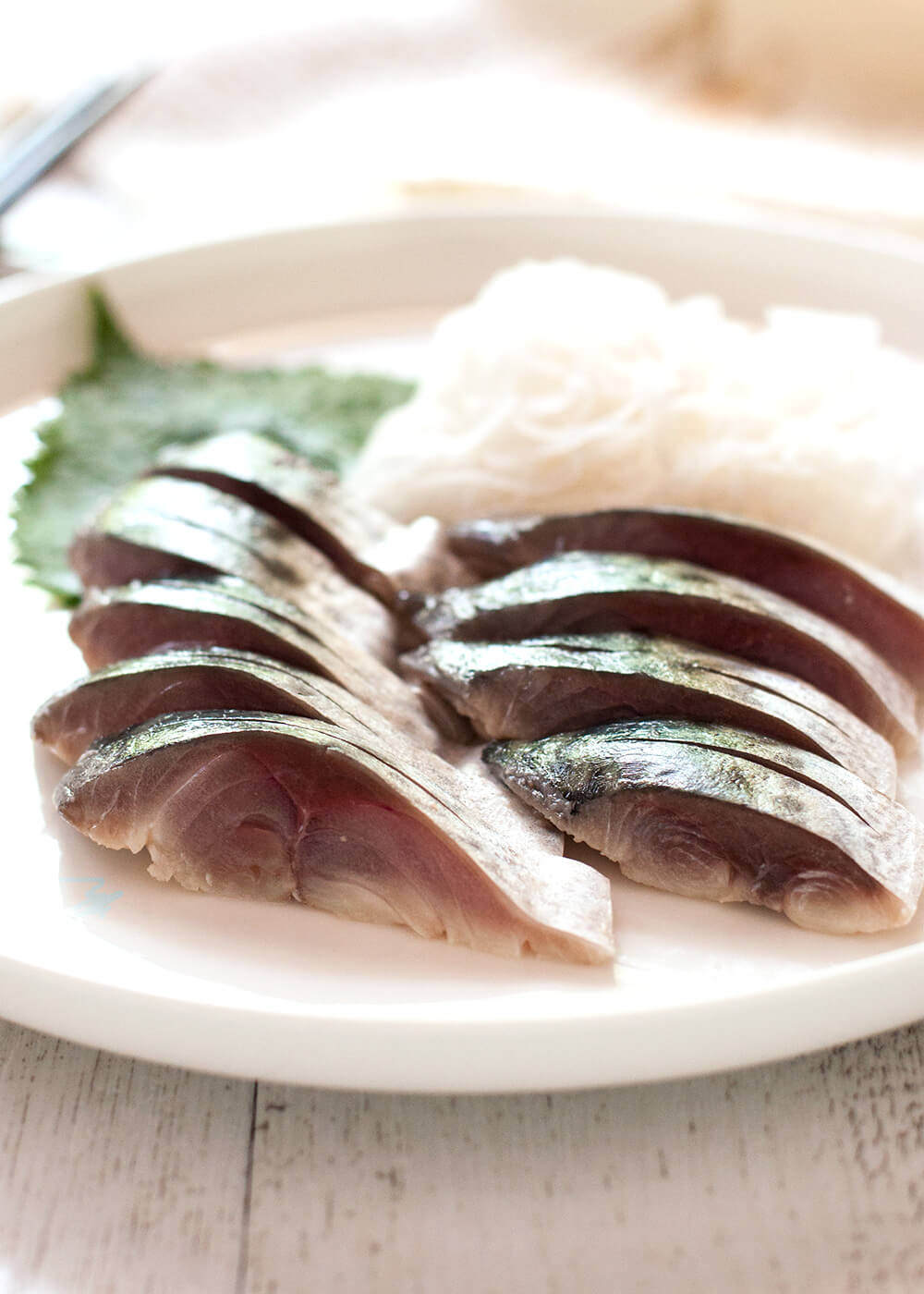 Filleting Mackerel
Filleting Mackerel
It is not very difficult to fillet mackerel as they have very soft bones.
- Chop the head off, cut the bottom of the belly and remove the guts.
- Run the knife down from the belly opening, towards the tail, along the back bone. Do the same on the dorsal side.
- Then push the tip of the knife through at the tail end of the meat, with the blade facing to the tail. Slide towards the tail but do not cut through so that the meat is intact at the tail end.
- Holding the tail, place the knife into the tail end slit, facing the blade to the head. Slide the knife along the back bone towards the head to make one side of fillet.
- Turn the fish over and repeat steps 2 – 4.
- Remove the rib cage by thinly slicing diagonally.
Importance of Covering the Fillets with Salt
Before marinating the fillets in rice wine vinegar, the fillets need to be covered with a generous amount of salt for about 1 hour. There are reasons for this:
- Add salty flavour
- Firm up the flesh
- Remove the fishy smell
As you can see in the step-by-step photo at the end of the recipe, quite a generous amount of salt is sprinkled over the fish.
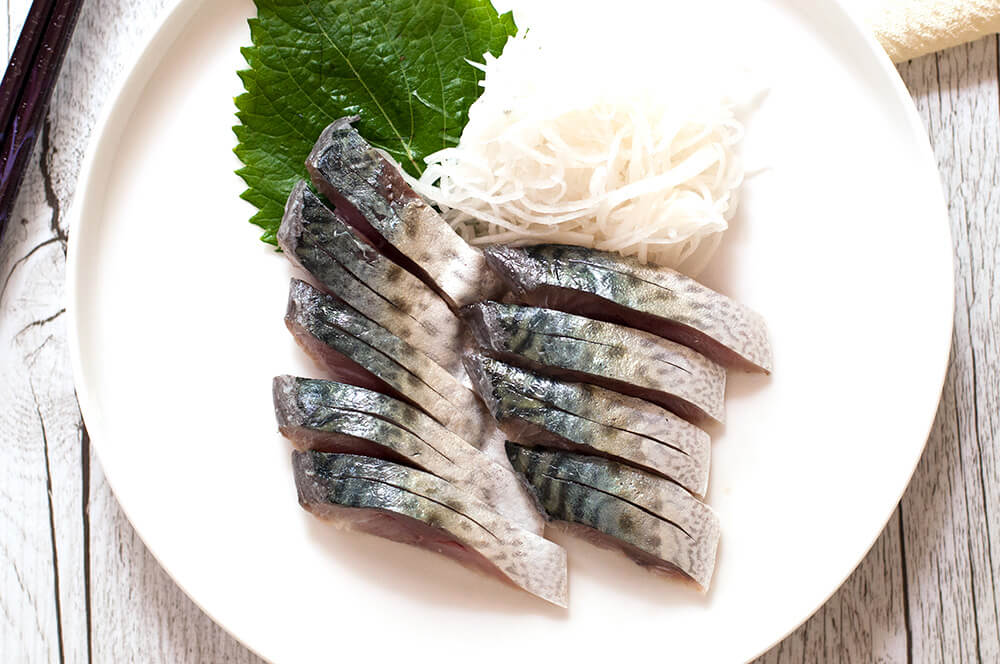 Marinating in Vinegar
Marinating in Vinegar
There are different versions of marinade for shime saba. The simplest marinade is just rice wine vinegar. I like this version and today’s recipe is this simple one. But if you like a slightly sweet flavour, you could add some sugar to it. Some recipes add a small piece of konbu (kelp).
It is all up to you and you can experiment to find the flavour that is best for you. It is such an easy way of preparing raw fish and is perfect for fish like mackerel.
The duration of marinating the fillets also varies and it depends on your liking. The minimum length of time is 15 minutes and the longest one I found on the Japanese recipe site was ½ a day. I marinate mine for a couple of hours. The more you marinate, the firmer the flesh becomes, and the colour of the flesh turns white as the vinegar penetrates into the flesh.
The duration of marinating and how far the flesh changes colour depends on the size of the fish.
Preparing for Sashimi/Sushi
You will need to remove the tiny bones which run where the back bone was. Then peel the thin skin off. It should be quite easy to peel the skin off once the fillets are marinated.
I slice the fillet differently depending on the purpose. If shime saba is for temakizushi (hand rolled sushi), which I will be posting soon, I slice the fillet almost straight down at a narrow width so that the fish can be easily rolled. See the photos below.
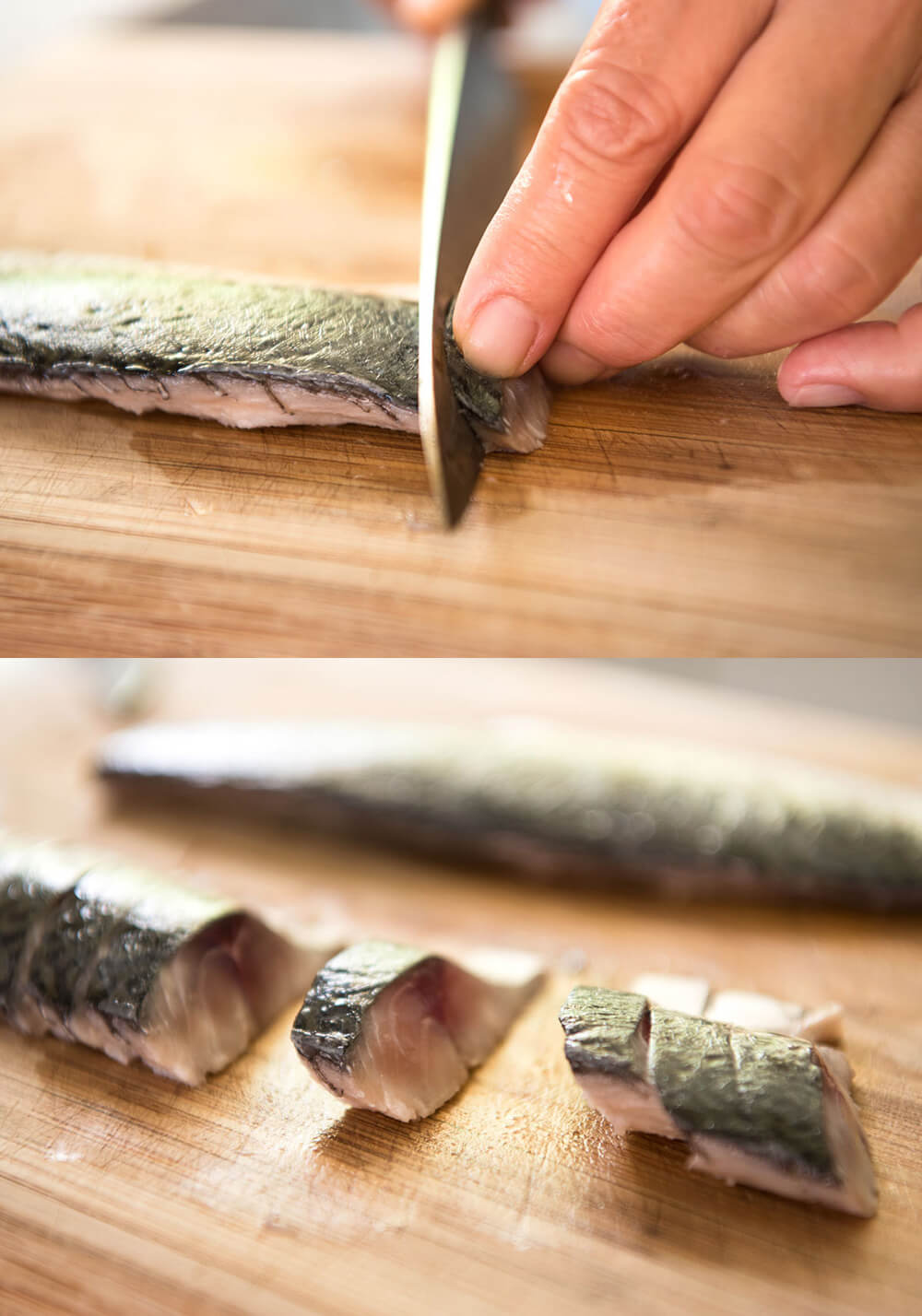
But if it is to be used for nigirizushi, I will slice the fillet diagonally with the knife tilted 45 degrees or more so that the sliced piece has a thin wide shape which is suitable to be placed on top of the rice ball.
When served as sashimi, like in the first photo, I usually slice either diagonally and not as wide as the sushi version, or slice like the temakizushi piece but wider. And I make a shallow incision on the skin in the centre of each slice.
There is a reason why I add a shallow slice in the middle when making sashimi. Because shime saba is made with the shiny skin on, it tends to repel soy sauce when dipped into it. By having an incision, it catches more soy sauce. Very thoughtful, don’t you agree?
As you can see in the recipe, there is no fixed amount of ingredients to make shime saba because it depends on the size of the fish, the size of the tray, and your preference. If you think about it, this is such a forgiving recipe. I hope you try shime saba.
Yumiko![]()
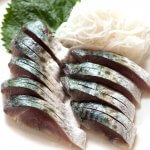
- Very fresh mackerel - cleaned and filleted with skin on (note 1)
- Salt - enough to cover both sides of fillet generously (note 2)
- Rice Wine Vinegar - enough to cover the fillet in a container/tray (note 3)
- Shredded daikon (white radish)
- Shiso (parella) leaves
-
Coat each fillet with generous amount of salt so that the entire surface of both skin side and flesh side are covered.
-
Place the fillets on a plate/tray ensuring that one side of the plate/tray is raised, so that the moisture extracted from the fillets will b collected on one side and does not soak the fillets (note 4). Leave it for 1 hour in the fridge.
-
Fill a bowl with water. Rinse the fillet gently in the bowl and pat dry with paper towel.
-
Place the fillets in a tray or a deep flat bottomed plate, add rice wine vinegar so that it almost covers the fillet. Leave for 2 hours in the fridge (note 5).
-
Place the fillet skin side down. Using a pair of tweezers, remove the small bones where the backbone was. If you run your finger along the centre of the fillet, you should feel the bones. (note 6)
-
Turn the fillet over and place it skin side up, pointing the tail end to the right (I am a right hander).
-
Starting from the tip of the head side of the fillet, which is on the left, pinch the corner of the very thin, semi-transparent skin and lift it up to start peeling.
-
Peel the skin towards the tail and remove the entire skin (note 7). As you peel the skin, hold the fillet on the head side with your left hand so that the fillet will not move.
-
Slice the fillet 1cm (⅜”) thick if you are serving it as part of temakizushi. If serving as sashimi, slice them 1.5cm (⅝”) thick and make a shallow incision in the middle on the skin. If using it as nigirizushi topping, slice it diagonally so that the width of the mackerel is about 3cm (1⅛”).
1. The two fillets I used were about 180g (6.3oz) in total.
2. I used about 19g (0.7oz) of salt to cover the two fillets.
3. This will entirely depend on the size of the container. A container/tray that just fits in two fillets would be most economical. I used about 250ml of vinegar to cover the fillets.
You could also use a zip lock plastic bag but I find that the vinegar will not penetrate evenly unless you can make the vinegar cover all of the fillet in some way.
4. I have a round steaming basket and I can adjust the diameter by opening and closing it. When fully opened, it becomes almost flat. So I use this basket placed on a plate to catch dripping from the fish as the moisture is extracted. Either way works fine.
5. Marinating time for the fillets depends on the size of the fillets, freshness of the fish and your preference of how much you want the fish to be cured.
The shortest time I found on the website is 15 minutes. This is almost like sashimi with a touch of vinegar flavour around the fillets. This is suitable only if the fish is extremely fresh. Some recipes leave it for 3 hours.
Marinating too long will make the entire flesh turn white which does not look appetising in my view.
6. The bones along the backbone are attached diagonal to the body of the fish. When removing the tiny bones, pull them in the direction of the bones so that they will not damage the flesh when pulled out.
7. When peeling the skin around the belly, try to pull the skin towards the belly, instead of towards the tail. Because the meat is very thin, it tends to break and go with the skin if you pull towards the tail. Once the skin in the belly area is peeled, then you can easily peel off the rest.
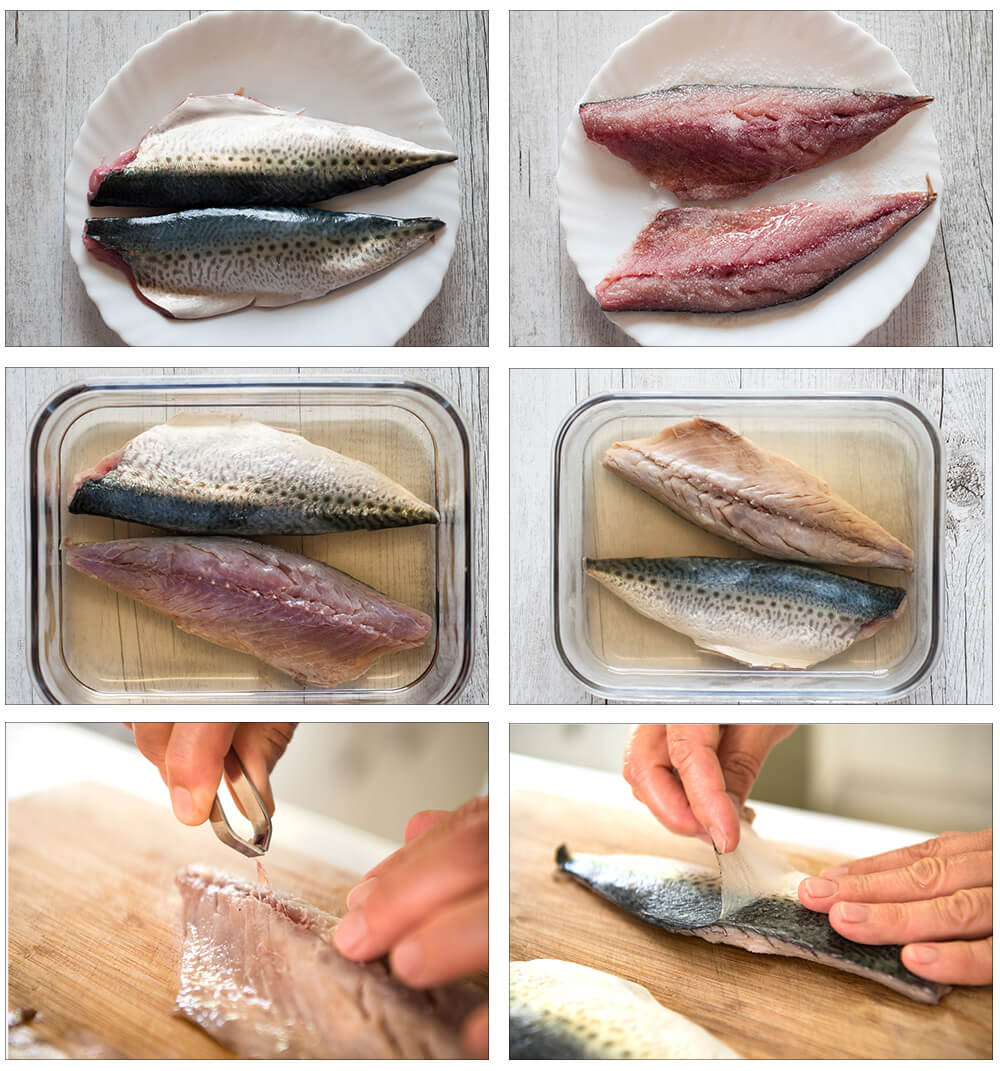
You might hate me, but I’m using a piece of Chinook salmon I caught…I love Saba so maybe I’ll love this too. I have made pickled Coho and loved it as a snack! I’ll let you know how the Shime Sake goes.
Hi Jerod, people do cure sashimi salmon in the similar way to Shime Saba in Japan. So, you did the right thing and I can imagine how good it would be! If you like saba, you will enjoy Shime Saba too.
I catch Pacific Mackerel out of a port named Depoe Bay, Oregon. They steal my bait but I’ll have the last laugh when they don’t get released but end up in some salt and vinegar next time! Thanks for your post it helps to find recipes for delicacies that can elude people that live only in their bubble. I cannot wait to try more recipes! I make Pinot Noir from the Southern Willamette Valley and would gladly give a bottle to you for sharing.
Hi Jerod, I haven’t been to Oregon but I looked at the map. Facing to Pacific ocean, you must catch abundance of good fish. Japanese say that almost any fish freshly caught can be eaten sashimi. I envy you for that. And you make wine too? Pino Noir is my favourite wine!
i am very lucky, i live close enough to Portland, Seattle, and Vancouver BC to experience excellent food, and most people around here love to share and experience cultures from around the Pacific. You happen to live in a place, as a biologist, I think only a tough breed of people can survive! Everything in Australia is venomous, and if it can’t send you to the hospital…it can spoil your day. Snakes, spiders, ants, crocs, etc.! Even the birds can harass you! Australia is wild and you must be tough to cohabit with animals that would give most ‘Westerners’ panic attacks…box jellies, sharks in rivers. The most venomous snakes on the planet…yet so much beauty too. Where I live in Oregon, there are no venomous animals ( a black widow spider and some wasps, that’s it!) If you leave the county I live in, we do have some venomous animals but NOTHING like any part of Australia! I will see if my friends that own a winery can ship you a bottle of Pinot, but Australia makes great wine too…it would be fun for you to compare our wines to yours…Your recipes have become my 2020 inspiration for cooking! Thanks again!
Hi Jerod, it is true that Australia has many dangerous animals. But they mostly live in the bush lands, not in the city areas where majority live. Having said that, I have to get pest control done every spring because I get venomous spiders every now and then… I used to scuba dive but once I saw a dozen of shark passing by beneath me, I stopped diving. It was few meters off shore. Apparently, they were tamed shark but I didn’t care. Haha.
I’d expect hearing more from you this year since you set your mind to try Japanese cooking!
The salmon done in this style was so good! I love it and will make this style fish with any fish I would eat raw from the Ocean…can you use Albacore tuna as well? Is there a more traditional way to pickle tuna or is that a taboo to use tuna?
jerod
Hi Jerod, yuu can cure tuna too. There is no taboo in the way you eat sashimi. It is said in Japan that any freshly caught fish can be eaten raw. Vinegar cured sashimi is suited for the fish with soft flesh and good flavour. Other fish includes yellowtail, sardine, Spanish mackerel, barracuda (small ones), snapper. They must be fresh and good for sashimi.
I agree 100%, and only cure it when I cannot eat it right away…mostly I believe one should leave fish in the Ocean to live and reproduce, rather than freeze. Except for when I want to smoke a salmon. Then I use a fish that is specially caught for smoking, Now I have found pickling is a good way to cure before freezing, if I have a little extra. Too bad friends, I have found a way to preserve my left over fish!
Hi,
Great recipe quick question, the very first picture is that with skin on?
Also the rice vinegar is unseasoned correct?
Thanks
Hi Seb, all the photos of Shime San are after skin was peeled off. When you cure mackerel, you will be able to remove only the semi-transparent skin on the surface, leaving the pattern underneath the thin skin.
And rice vinegar is unseasoned, straight from the bottle.
Hi! Do you think you can use the same procedure with trevally or Aji? Trevally is fairly cheap here in NZ and is one of my favourite fish to eat as sashimi! Many thanks
Hi Seiki, of course you can. Trevally can get very large so try to buy smaller size fish. I love trevally sashimi, too!
Excellent recipe. We have Jack mackerel in NZ (Tracherus declivis, T. novaezelandiae, T. murphyi) and also the blue version you use and both are great when vertually still kicking are in the smoker. Caught a blue mackerel yesterday and added it to soy and lemon juice…hooked! Decided to look up sushimi recipes and found yours. Will give it a try! Read somewhere of putting some ginger in too is great but marinating never dawned on us so back to experimenting! The joys of being a liveaboard.
Hi Steve, lucky you to have caught a blue mackerel. Nothing is better than freshly caught fish. Whenever we caught fish, we made sashimi, first. Good luck with Shime Saba. I hope you like it.
Is makeral caught yesterday considered “very fresh”… fresh enough for sashimi?
Hi Nancy, providing that you removed guts on the day you caught the fish, you can make Shime Saba the next day. But not sashimi without curing. Mackerel loses freshness quickly so you can only make sashimi on the day you caught.
Love mackerel this way when i catch it fresh, but i have a question – how long can the vinegar/sugar marinade be saved for reuse? Does anyone know?
Hi Penn, I read in the Japanese article that as long as you top up the vinegar marinade, you can reuse it many times. You can also use the remaining marinade for salad dressing. It has a bit of fishiness but some say that the fishiness adds umami to the dressing.
Hi, great blog! Does it also work with frozen mackarel filets?
Hi Dom,
If the frozen mackerel fillet is sold as ‘for sashimi’, then you can do it but if it is just for cooking, they I am afraid the fillet is not suited for Shime Saba.
Looks delicious!! How long will the Saba keep after the marinade process is complete?
Hi Rick, I marinated only a couple of hours in this recipe so I would suggest that you consume saba by end of next day. But if you marinate the fish longer, say 1-2 days, until all the flesh becomes white, you can keep it for several days in the fridge. The only thing is that the saba becomes more like marinated fish with vinegar flavour. Actually, completely marinated saba is also a proper dish.
Hey Yumiko, made this last night and is was delicious, best Saba I ever tasted! Definitely a keeper recipe, thanks for posting it!!!
Hi rick, that’s really great to hear you liked it. I love saba and every time I go to a sushi shop in Japan, shime saba sushi is one of the first nigirizushi I order.
Just finished salting, about to soak in vinegar. I’m using fresh mackarel my father and I caught this morning in South Florida. 🙂
You are lucky to have such fresh mackerel! I bet it will be yummy.
Yumko-san. Domo arigato.
I have been looking for this for a long time. shimesaba is one of the tastes of Japan that I miss most. Of course, I can buy it in the Nihon-machi store are vacuum packages in plastic. But I wanted to make it myself. I have an excellent fish store and will buy saba next time I am there..
Hi David, I love shime saba, too. Actually, I love anything to do with saba. Let me know how it goes.
EXCELENT RECIPE AND VERY TRADITIONAL IT IS REAL JAPAN FOOD!!!
Hi Carlos, thanks a lot!